Engineering Properties of Novel Vertical Cutoff Wall Backfills Composed of Alkali-Activated Slag, Polymer-Amended Bentonite and Sand
Abstract
:1. Introduction
2. Materials and Methods
2.1. Materials
2.2. Preparation of Backfills
2.3. Testing Methods
3. Results and Analyses
3.1. Workability
3.2. pH, Void Ratio, and Dry Density
3.3. Hydraulic Conductivity
3.4. Unconfined Compressive Strength, Strain at Failure and E50
3.5. Pore Size Distribution
4. Discussion
4.1. Effects of PAC on Hydraulic Conductivity
4.2. Effects of PAC Amendment on Mechanical Properties
5. Study Limitations
6. Conclusions
- (a)
- The PAC amendment yielded a 9% increase in moisture content corresponding to the target slump height for the backfill, which was because the carboxyl (-CH2COOH) and hydroxyl (-OH) functional groups of PAC combined with free water molecules. The MSBS-PAC backfill possessed lower pH and dry density, and higher void ratio than MSBS backfill.
- (b)
- The PAC amendment reduced the k of the backfill by approximately one order of magnitude after 28-day and 90-day curing. With the addition of PAC, the pore volume proportion of macropores in the backfill decreased from 4.3% to 2.7%, while the micropores volume increased from 0.9% to 2.7%. The PAC hydrogel could form a narrow and tortuous flow path inside the backfill, which hindered the flow of permeating liquid and decreased the hydraulic conductivity. In addition, the protective “thin coating” caused by the addition of PAC enhanced resistance against the impact of multi-valence metal ions on bentonite in the backfill.
- (c)
- The qu and εf of the MSBS-PAC backfill were lower than those of the MSBS backfill, while the MSBS-PAC backfill yielded a higher E50. The reasons were attributed to the promotion of water absorption with the hydrophilic functional groups of PAC.
Author Contributions
Funding
Data Availability Statement
Conflicts of Interest
References
- Ryan, C.R.; Day, S.R. Soil-cement-bentonite slurry walls. In Deep Foundations 2002: An International Perspective on Theory, Design, Construction, and Performance; Geotechnical Special Publication; ASCE: Reston, VA, USA, 2002; pp. 713–727. [Google Scholar]
- Yang, Y.L.; Reddy, K.R.; Du, Y.J.; Fan, R.D. Short-term hydraulic conductivity and consolidation properties of soil-bentonite backfills exposed to CCR-impacted groundwater. J. Geotech. Geoenviron. Eng. 2018, 144, 04018025. [Google Scholar] [CrossRef]
- Shi, J.; Lei, G.; Zhang, J.; Wei, Y.; Li, Y.P.; Sun, Z.; Zhang, Y. A unit-cell model for thermal regulation of degradation of organics in solid waste. Waste Manage. Res. 2020, 38, 680–688. [Google Scholar] [CrossRef] [PubMed]
- Jiang, Z.Y.; Zhang, R.; Fu, X.L.; Wan, J.L.; Li, S.J.; Yang, Y.L.; Du, Y.J. Investigation of hydraulic conductivity of SHMP amended soil-bentonite backfills exposed to lead-impacted groundwater. In Proceedings of the GeoChina 2021, Nanchang, China, 19–21 July 2021; pp. 1–13. [Google Scholar]
- Opdyke, S.M.; Evans, J.C. Slag-cement-bentonite slurry walls. J. Geotech. Geoenviron. Eng. 2005, 131, 673–681. [Google Scholar] [CrossRef]
- Du, Y.; Fan, R.; Reddy, K.R.; Liu, S.; Yang, Y. Impacts of presence of lead contamination in clayey soil: Calcium bentonite cutoff wall backfills. Appl. Clay Sci. 2015, 108, 111–122. [Google Scholar] [CrossRef]
- Yang, Y.L.; Reddy, K.R.; Zhang, T.; Fan, R.D.; Fu, X.L.; Du, Y.J. Enhanced contaminant retardation by novel modified calcium bentonite backfill in slurry trench cutoff walls. Construct. Build. Mater. 2022, 320, 126285. [Google Scholar] [CrossRef]
- Wu, H.L.; Jin, F.; Ni, J.; Du, Y.J. Engineering properties of vertical cutoff walls consisting of reactive magnesia-activated slag and bentonite: Workability, strength, and hydraulic conductivity. J. Mater. Civ. Eng. 2019, 31, 04019263. [Google Scholar] [CrossRef]
- Abdalqader, A.; Jin, F.; Al-Tabbaa, A. Performance of magnesia-modified sodium carbonate-activated slag/fly ash concrete. Cem. Concr. Compos. 2019, 103, 160–174. [Google Scholar] [CrossRef]
- Feng, Y.S.; Zhou, S.J.; Zhou, A.; Xia, W.Y.; Li, J.S.; Wang, S.; Du, Y.J. Reuse of a contaminated soil stabilized by a low-carbon binder as roadway subgrade material and mechanical performance evaluation. Eng. Geol. 2022, 303, 106656. [Google Scholar] [CrossRef]
- Du, Y.J.; Wu, J.; Bo, Y.L.; Jiang, N.J. Effects of acid rain on physical, mechanical and chemical properties of GGBS–MgOsolidified/stabilized Pb-contaminated clayey soil. Acta Geotech. 2019, 15, 923–932. [Google Scholar] [CrossRef]
- Feng, Y.S.; Zhou, S.J.; Zhou, A.; Jiang, N.J.; Xia, W.Y.; Wang, S.; Du, Y.J. Environmental performance of reusing a contaminated soil solidified/stabilized by a low-carbon binder as roadway subgrade material. J. Clean. Prod. 2022, 375, 134125. [Google Scholar] [CrossRef]
- Han, X.; Jiang, N.; Jin, F.; Reddy, K.R.; Wang, Y.; Liu, K.; Du, Y. Effects of biochar-amended alkali-activated slag on the stabilization of coral sand in coastal areas. J. Geotech. Geoenviron. Eng. 2023, 15, 760–772. [Google Scholar] [CrossRef]
- Jefferis, S. Cement-bentonite slurry systems. In Grouting and Deep Mixing; Johnsen, L.F., Bruce, D.A., Byle, M.J., Eds.; ASCE: Reston, VA, USA, 2012; pp. 1–24. [Google Scholar]
- Wu, H.L.; Jin, F.; Du, Y.J. Influence of wet-dry cycles on vertical cutoff walls made of reactive magnesia-slag-bentonite-soil mixtures. J. Zhejiang Univ.-Sci. 2019, 20, 948–960. [Google Scholar] [CrossRef]
- Wu, H.L.; Jin, F.; Zhou, A.N.; Du, Y.J. The engineering properties and reaction mechanism of MgO-activated slag cement-clayey sand-bentonite (MSB) cutoff wall backfills. Construct. Build. Mater. 2021, 271, 121890. [Google Scholar] [CrossRef]
- Fu, X.L.; Wu, H.L.; Zhang, R.; Jiang, Z.Y.; Reddy, K.R.; Du, Y.J. Heavy metals containment by vertical cutoff walls backfilled with novel reactive magnesium-activated slag-bentonite-sand: Membrane and diffusion behavior. J. Clean. Prod. 2021, 328, 12962. [Google Scholar] [CrossRef]
- Ni, J. Hydraulic Performance and Micro Mechanism of Active MgO-GGBS-Bentonite Vertical Cutoff Wall. Master’s Thesis, Southeast University, Nanjing, China, 2021. [Google Scholar]
- Murray, H. Industrial clays case study. Min. Miner. Sustain. Dev. 2002, 64, 1–9. [Google Scholar]
- Fu, X.L.; Jiang, Z.Y.; Reddy, K.R.; Ruan, K.L.; Du, Y.J. Hydraulic Conductivity, Microstructure and Compositional Changes of Sand-Bentonite Backfill in Cutoff Walls Exposed to Organic Acids. J. Geotech. Geoenviron. Eng. 2023, 149, 04023060. [Google Scholar] [CrossRef]
- Tian, K.; Likos, W.J.; Benson, C.H. Polymer elution and hydraulic conductivity of bentonite–polymer composite geosynthetic clay liners. J. Geotech. Geoenviron. Eng. 2019, 145, 04019071. [Google Scholar] [CrossRef]
- Ni, H.; Shen, S.Q.; Fu, X.L.; Wang, C.M.; Du, Y.J. Assessment of membrane and diffusion behavior of soil-bentonite slurry trench wall backfill consisted of sand and Xanthan gum amended bentonite. J. Clean. Prod. 2022, 365, 132779. [Google Scholar] [CrossRef]
- Fu, X.L.; Shen, S.Q.; Reddy, K.R.; Yang, Y.L.; Du, Y.J. Hydraulic cnductivity of sand/biopolymer-amended bentonite backfills in vertical cutoff walls permeated with lead solutions. J. Geotech. Geoenviron. Eng. 2022, 148, 04021186. [Google Scholar] [CrossRef]
- Jensen, O.M.; Hansen, P.F. Water-entrained cement-based materials II. Experimental observation Cem. Concr. Res. 2002, 32, 973–978. [Google Scholar] [CrossRef]
- Craeye, B.; Geirnaert, M.; De Schutter, G. Super absorbing polymers as an internal curing agent for mitigation of early-age cracking of high-performance concrete bridge decks. Construct. Build. Mater. 2011, 25, 1–13. [Google Scholar] [CrossRef]
- Shen, S.Q.; Wei, M.L. Hydraulic conductivity of polymer-amended sand-bentonite backfills permeated with lead nitrate solutions. Adc. Civ. Eng. 2018, 2018, 9435194. [Google Scholar] [CrossRef]
- Du, Y.J.; Shen, S.Q.; Tian, K.; Yang, Y.L. Effect of polymer amendment on hydraulic conductivity of bentonite in calcium chloride solutions. J. Mater. Civ. Eng. 2021, 33, 04020452. [Google Scholar] [CrossRef]
- Fu, X.L.; Zhuang, H.; Reddy, K.R.; Jiang, N.J.; Du, Y.J. Novel composite polymer-amended bentonite for environmental containment: Hydraulic conductivity, chemical compatibility, enhanced rheology and polymer stability. Constr. Build. Mater. 2023, 378, 131200. [Google Scholar] [CrossRef]
- Shen, S.Q. Containment Performances of Sand-Polymer Amended Bentonite Vertical Barriers Exposed to Heavy Metal Contaminants. Ph.D. Thesis, Southeast University, Nanjing, China, 2019. [Google Scholar]
- ASTM D4972; Standard Test Methods for Classification of Soils for Engineering Purposes (Unified Soil Classification System). ASTM: West Conshohocken, PA, USA, 2019.
- GB/T 18046; Ground Granulated Blast Furnace Slag Used for Cement, Mortar and Concrete. Inspection and Quarantine of the People’s Republic of China: Beijing, China, 2017.
- ASTM C143/C143M; Standard Test Methods for Slump of Hydraulic-Cement Concrete1. ASTM: West Conshohocken, PA, USA, 2012.
- ASTM D5084; Standard Test Methods for Measurement of Hydraulic Conductivity of Saturated Porous Materials Using a Flexible Wall Permeameter. ASTM: West Conshohocken, PA, USA, 2016.
- ICE (Institution of Civil Engineers). Specification for the Construction of Slurry Trench Cut-Off Walls as Barriers to Pollution Migration; Thomas Telford: London, UK, 1999. [Google Scholar]
- HG/T 20715; Technical Code for Engineered Vertical Barriers at Industrial Contaminated Sites. Ministry of Industry and Information Technology of the People’s Republic of China: Beijing, China, 2020.
- Horpibulsuk, S.; Bergado, D.T.; Lorenzo, G.A. Compressibility of cement-admixed clays at high water content. Geotechnique 2004, 54, 151–154. [Google Scholar] [CrossRef]
- ASTM D4219; Standard Test Method for Unconfined Compressive Strength Index of Chemical-Grouted Soils. ASTM: West Conshohocken, PA, USA, 2008.
- Kleinberg, R.L. Utility of NMR T2 distributions, connection with capillary pressure, clay effect, and determination of the surface relaxivity parameter ρ2. Magn. Reson. Imagin. 1996, 14, 761–767. [Google Scholar] [CrossRef]
- Jiang, Z.; Cai, G.; Tian, G.; Liu, X. Effect of aggregate particle size on mortar pore structure. Constr. Build. Mater. 2022, 352, 128988. [Google Scholar] [CrossRef]
- Cao, B.; Zhang, Y.; Xu, J.; Al-Tabbaa, A. Use of superabsorbent polymer in soil-cement subsurface barriers for enhanced heavy metal sorption and self-healing. Sci. Total Environ. 2022, 831, 154708. [Google Scholar] [CrossRef]
- Daheur, E.G.; Li, Z.S.; Demdoum, A.; Taibi, S.; Goual, I. Valorisation of dune sand-tuff for Saharan pavement design. Constr. Build. Mater. 2023, 366, 130239. [Google Scholar] [CrossRef]
- Suzuki, S.; Prayongphan, S.; Ichikawa, Y.; Chae, B.G. In situ observations of the swelling of bentonite aggregates in NaCl solution. Appl. Clay Sci. 2005, 29, 89–98. [Google Scholar] [CrossRef]
- Mohanty, B.P. Scaling hydraulic properties of a macroporous soil. Water Resour. Res. 1999, 35, 1927–1931. [Google Scholar] [CrossRef]
- Schröfl, C.; Mechtcherine, V.; Gorges, M. Relation between the molecular structure and the efficiency of superabsorbent polymers (SAP) as concrete admixture to mitigate autogenous shrinkage. Cement Concrete Res. 2012, 42, 865–873. [Google Scholar] [CrossRef]
- Ren, X.W.; Santamarina, J.C. The hydraulic conductivity of sediments: A pore size perspective. Eng. Geol. 2018, 233, 48–54. [Google Scholar] [CrossRef]
- Cao, B.Y.; Chen, J.; Al-Tabbaa, A. Crack-resistant cement–bentonite cut-off wall materials incorporating superabsorbent polymers. Can. Geotech. J. 2021, 58, 800–810. [Google Scholar] [CrossRef]
- Hasholt, M.T.; Jensen, O.M.; Kovler, K.; Zhutovsky, S. Can superabsorent polymers mitigate autogenous shrinkage of internally cured concrete without compromising the strength? Constr. Build. Mater. 2012, 31, 226–230. [Google Scholar] [CrossRef]
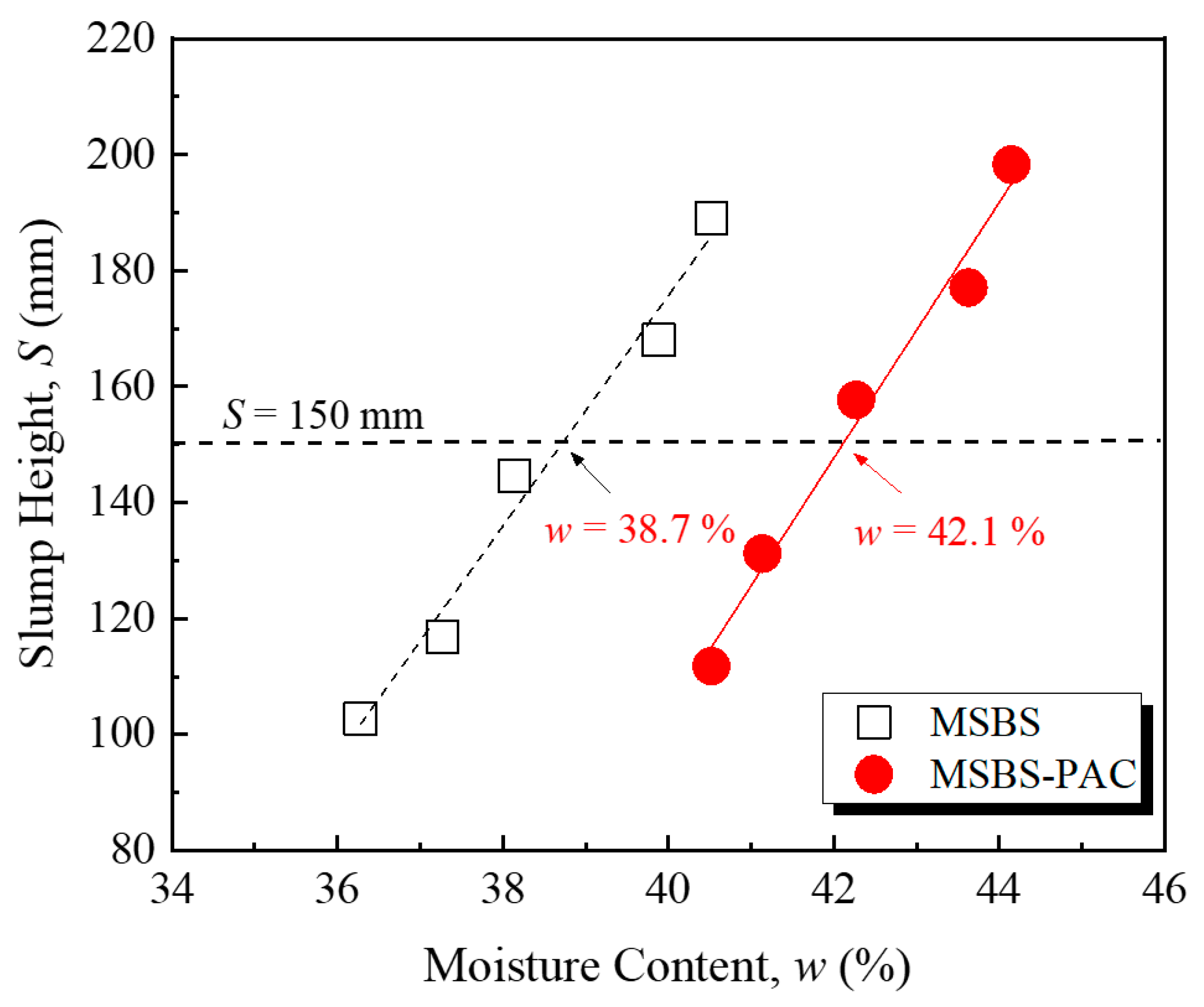
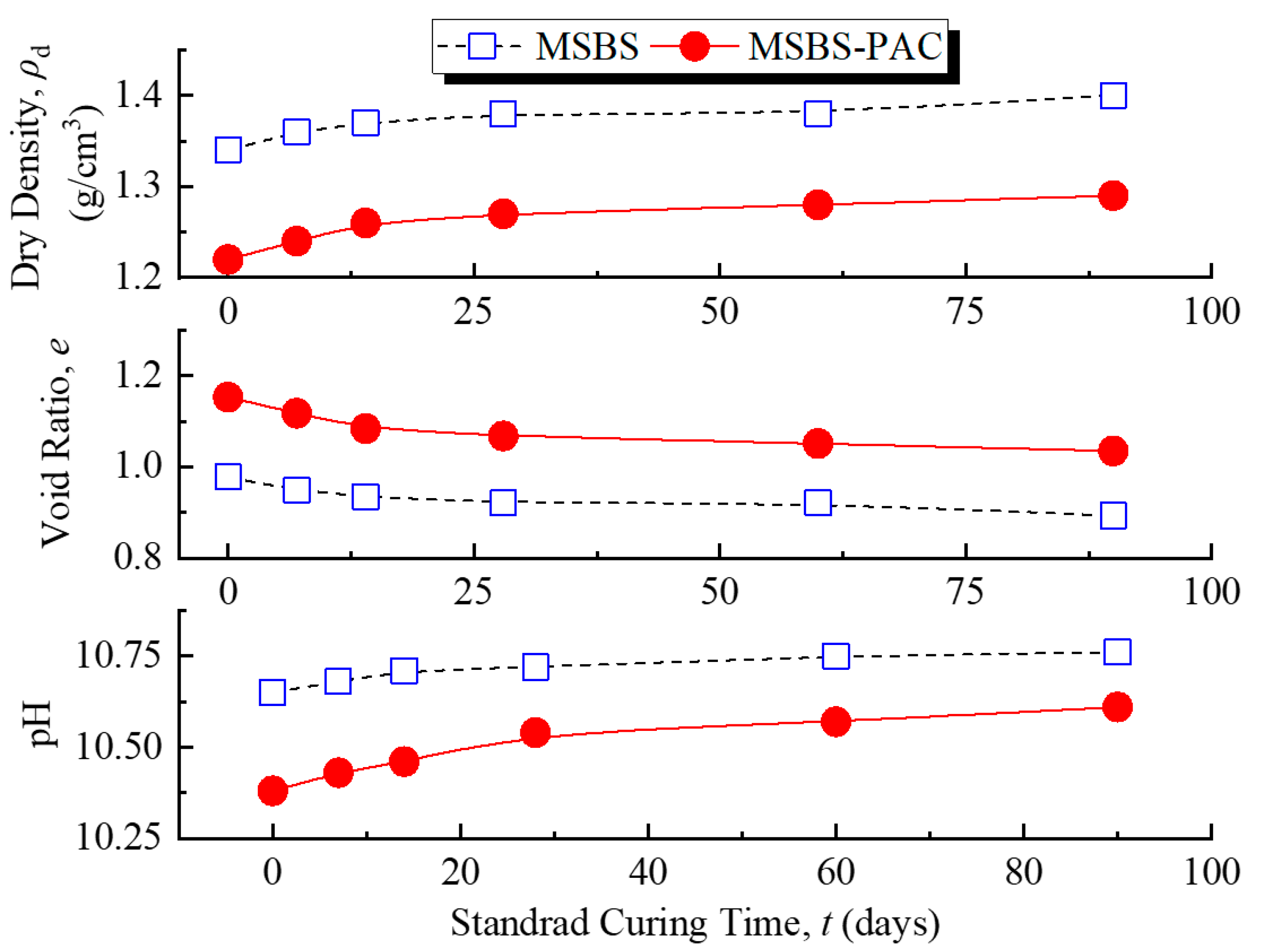
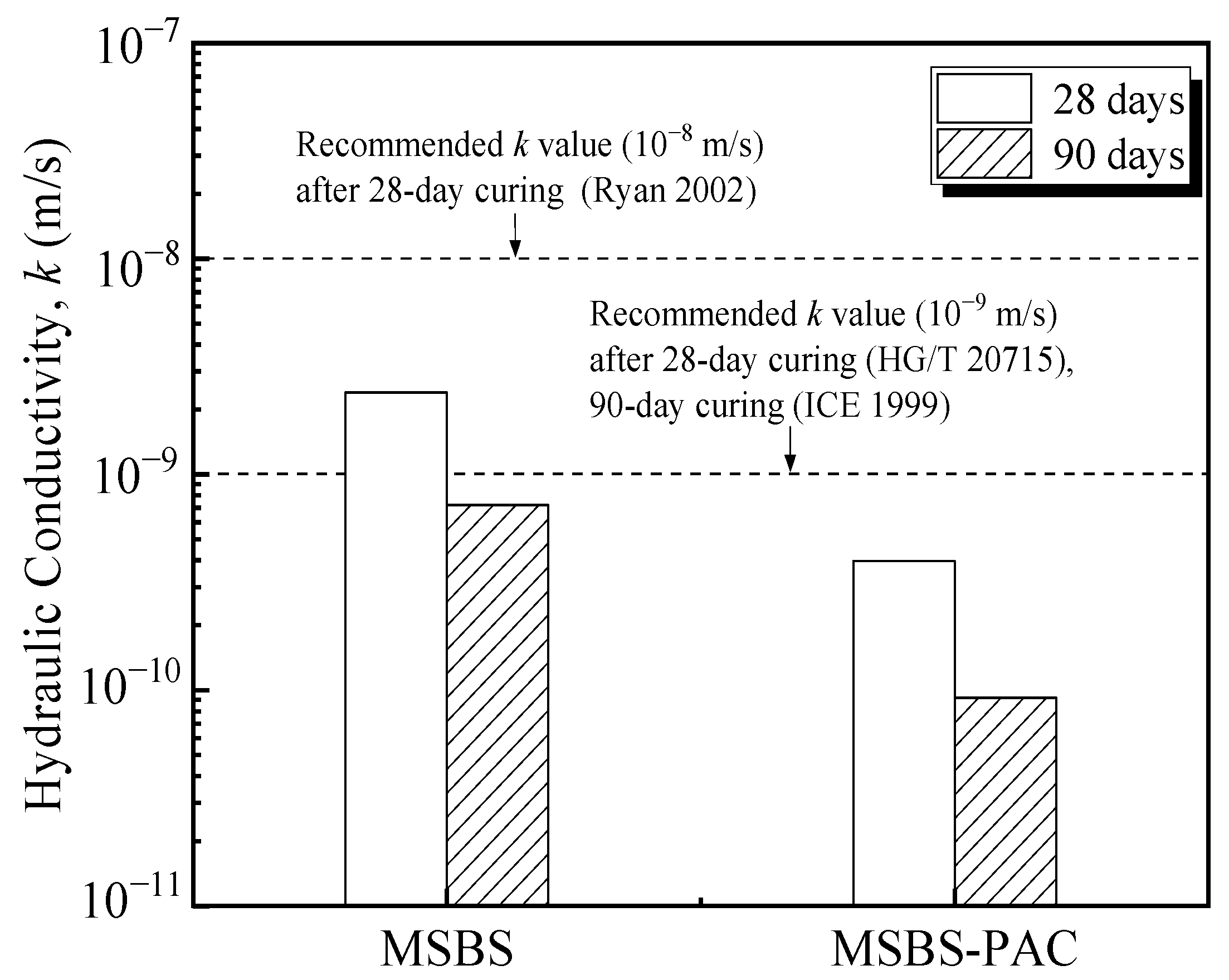


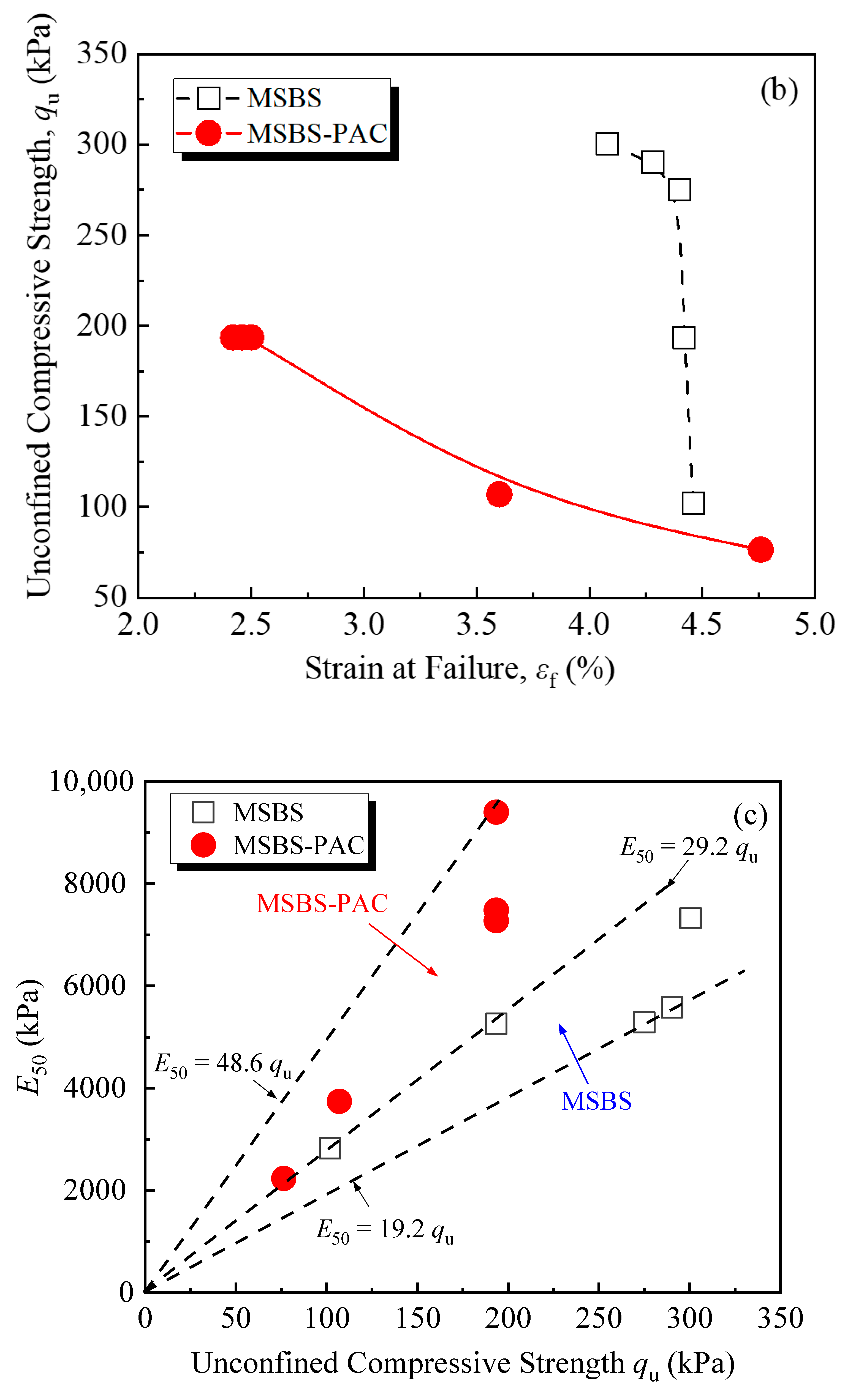
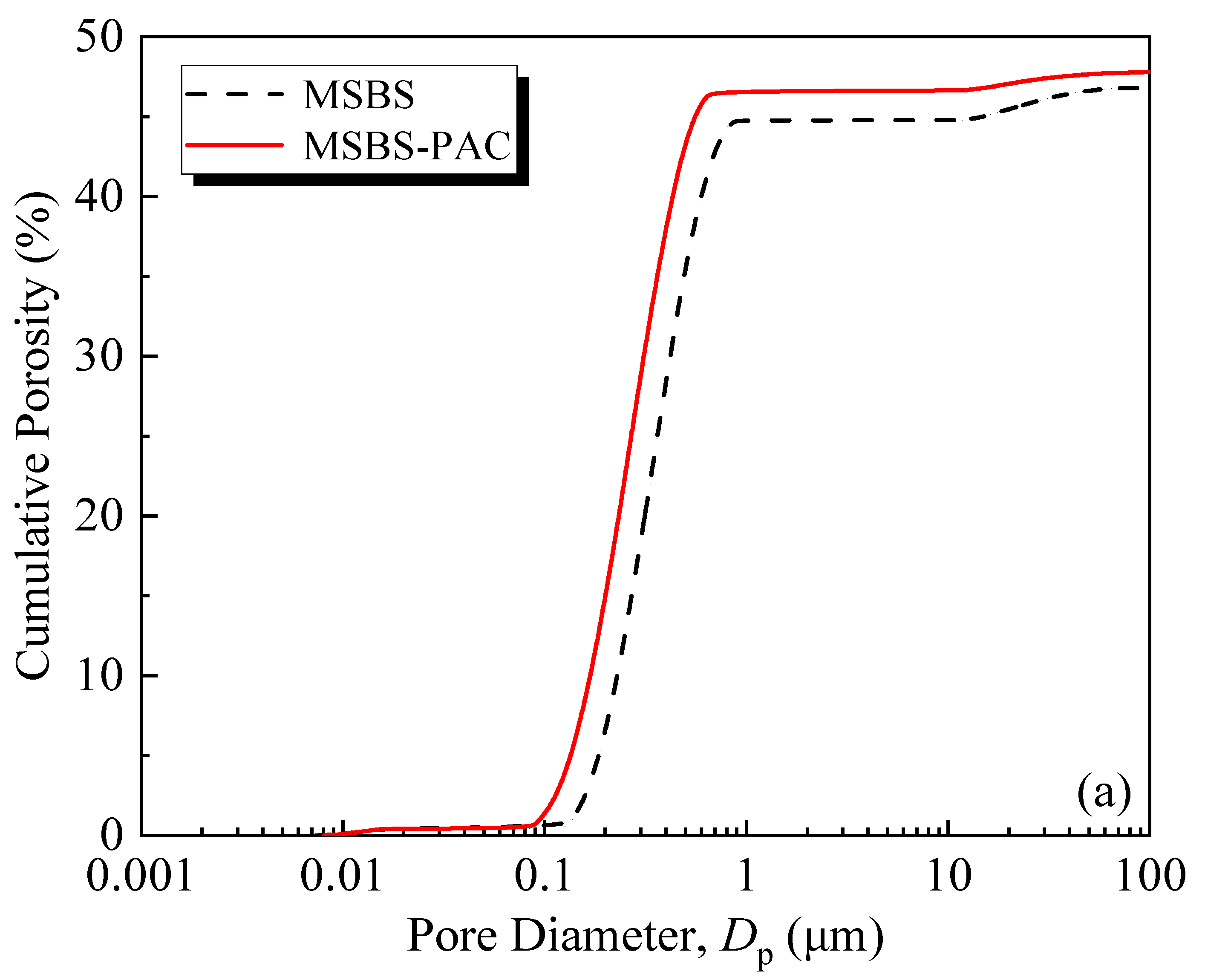

| Category ID | Sand | GGBS | MgO | CB | PAC |
|---|---|---|---|---|---|
| MSBS | 100 | 4.5 | 0.5 | 10 | 0 |
| MSBS-PAC | 100 | 4.5 | 0.5 | 10 | 0.2 |
Disclaimer/Publisher’s Note: The statements, opinions and data contained in all publications are solely those of the individual author(s) and contributor(s) and not of MDPI and/or the editor(s). MDPI and/or the editor(s) disclaim responsibility for any injury to people or property resulting from any ideas, methods, instructions or products referred to in the content. |
© 2023 by the authors. Licensee MDPI, Basel, Switzerland. This article is an open access article distributed under the terms and conditions of the Creative Commons Attribution (CC BY) license (https://creativecommons.org/licenses/by/4.0/).
Share and Cite
Jiang, Z.; Fu, X.; Shi, J.; Che, C.; Du, Y. Engineering Properties of Novel Vertical Cutoff Wall Backfills Composed of Alkali-Activated Slag, Polymer-Amended Bentonite and Sand. Polymers 2023, 15, 3059. https://doi.org/10.3390/polym15143059
Jiang Z, Fu X, Shi J, Che C, Du Y. Engineering Properties of Novel Vertical Cutoff Wall Backfills Composed of Alkali-Activated Slag, Polymer-Amended Bentonite and Sand. Polymers. 2023; 15(14):3059. https://doi.org/10.3390/polym15143059
Chicago/Turabian StyleJiang, Zheyuan, Xianlei Fu, Jianyong Shi, Chi Che, and Yanjun Du. 2023. "Engineering Properties of Novel Vertical Cutoff Wall Backfills Composed of Alkali-Activated Slag, Polymer-Amended Bentonite and Sand" Polymers 15, no. 14: 3059. https://doi.org/10.3390/polym15143059





